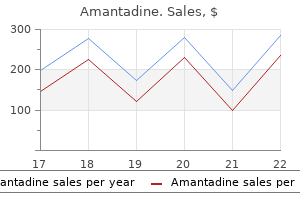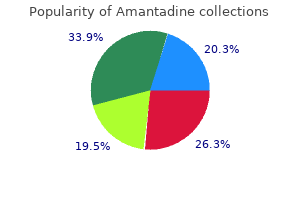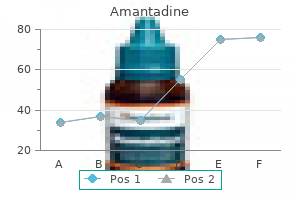Amantadine

"Buy discount amantadine 100 mg on line, anti viral fungal fighter".
H. Gnar, M.A., M.D., M.P.H.
Assistant Professor, Philadelphia College of Osteopathic Medicine
Statistical analysis of surface exposed parts of experimentally determined IgE epi- S hiv infection rates in the united states cheap 100 mg amantadine mastercard. The program objective is to spark new interest in food allergy research and approaches for safety assessment of potential dietary allergens including proteins introduced into food through genetic engineering hiv infection rates with condom cheap amantadine 100 mg line. An additional major goal of the program is to encourage new investigators to move into the field of food allergy research hiv infection rate colombia amantadine 100mg with amex. The initiative supports basic research on factors that contribute to the development of food allergies antiviral herpes zoster cheap amantadine 100mg with mastercard, the relationship between food allergies and other immune disorders, and the epidemiology and genetics of food allergy, as well as methods to predict the allergenicity of novel proteins in food. Epidemiological studies on the prenatal and maternal factors involved in oral tolerance and sensitization will help delineate sensitive populations and the probability for development of food allergy. An improved understanding of the basic immunology of food sensitization should illuminate the most important factors to consider for ensuring the safety of new bioengineered proteins or new exposures to proteins in food. Transcript profiling technology has been around for a decade and is arguably the most developed systems biology approach that has been applied to drug safety assessment. In part, the lack of publication leads to the impression that transcriptomics has had little impact. Specific examples where transcriptomics are being applied to preclinical drug safety assessment will be higlighted as will the areas of success in addition to areas where transcriptomics has had less impact. The emphasis will be on case studies outlining applications that are being integrated into safety assessment and where the technology is being reduced to practice. The impact of the technology among scientists in industry and the regulatory community will be illustrated by sharing both positive and negative experiences. Industry scientists will present case studies that illustrate the use of transcriptomics to understand issues or risks that emerge in preclinical development. Finally, the opportunities and challenges for applying transcriptomics to drug safety assessment will be summarized. To date, transcriptional profiling of rodent liver or cultured hepatocytes has shown direct application to predicting toxicity, such as the identification of a battery of genes that can predict phospholipidosis or the likelihood of non-genotoxic hepatocarcinogenesis. A major strength of transcriptional profiling studies is the ability to probe the entire genome in a single experiment, and this attribute has enabled the development of cogent hypotheses for mechanisms of toxicity and directed experimental strategies and approaches in situations that might otherwise be intractable. Additional efforts to assess transcriptional profiles in other target organs such as testes have demonstrated that these data can differentiate mechanisms of toxicity in a tissue of mixed cell types. Furthermore, transcriptional profiling data readily distinguish slow and fast twitch skeletal muscle and provide the foundation for exploring mechanisms of drug-induced myopathy. Data quality and utility are influenced by fundamental elements of experimental design including dose selection, time of analysis, anchoring to histopathologic changes and integration of effects in other tissues, and these parameters must be carefully considered when executing and evaluating transcriptional profiling studies. Building on experiences with transcriptional data that address mechanism or predict toxicity will continue to enhance the application of these data to risk assessment. The rapid development and evolution of genomic, proteomic, and metabonomic based technologies has led to the development of the field of "toxicogenomics. This is being accomplished by facilitating better understanding of the mechanisms by which compound induced injury occurs coupled with the potential for identification of early, sensitive biomarkers of toxicity. The scientific community, academic, industry and regulatory groups have all put forth efforts targeted at evaluating the development and use of genomics technologies in toxicology. A number of industry-related case studies around predictive toxicology and issue resolution were reviewed in the context of scientific and regulatory impact/perspective. In the pharmaceutical industry, toxicity represents a major cause of failure at the costly stages of development, and reducing late-stage attrition due to toxicity can decrease overall research and development costs. The use of transcriptomics in toxicology, also known as toxicogenomics, represents one of the few recent technological advances that has improved the detection and mechanistic characterization of toxic changes in preclinical species. Published reports and our internal data have provided strong evidence that toxicogenomics is a viable and useful methodology to evaluate compounds in discovery and to develop a mechanistic understanding of toxic events at later stages in development. In the industry, toxicology has traditionally been an observational discipline that uses a limited number of endpoints with mechanistic value. In contrast, global evaluation of transcriptomic changes constitutes a rapid approach to detect abnormalities in subcellular compartments or deregulation of biological pathways. Accurate analysis and understanding of these complex data sets is largely facilitated by the use of pathway analysis software packages and by the access to repositories of reference gene expression profiles. This higher level of clarity represents a robust and efficient approach for toxicologists to rapidly formulate data-driven hypotheses regarding the mechanisms of toxic changes. These hypotheses typically need to be confirmed or refuted in follow-up functional experiments using appropriate complementary technologies.
If tyrosine derived from the diet or from the metabolism of phenylalanine is not metabolized hiv infection from woman to man generic amantadine 100 mg on line, it accumulates in the serum up to 100 times normal hiv infection viral load generic amantadine 100mg amex, producing tyrosinemia and overflow into the urine (tyrosyluria) antiviral valacyclovir side effects amantadine 100mg mastercard. Cirrhosis of the liver zinc finger antiviral protein 100 mg amantadine free shipping, renal dysfunction, and rickets are the principal clinical findings in hereditary tyrosinemia, which is rare. A screening test to detect tyrosine in urine uses nitrosonaphthol, which forms red complexes with tyrosine and tyramine, but is nonspecific. Chromatography should be used to confirm the presence of increased levels of tyrosine because normal urine contains some tyrosine. Failure to inherit the gene for the enzyme necessary to produce oxidative decarboxylation of the keto acids in the metabolic pathways of leucine, isoleucine, and valine results in their accumulation in the blood and urine. In certain intestinal disorders, including obstruction, the presence of abnormal bacteria, malabsorption syndromes, or a rare inherited disorder (Hartnup disease), increased amounts of tryptophan are converted to indole in the intestine. The excess indole is then reabsorbed into the blood and converted to indican by the liver and excreted into the urine. Urinary indican is detected by an acidic ferric chloride solution, which reacts with indican to form a deep-blue or purple color. In another metabolic pathway, tryptophan is converted to serotonin in the argentaffin cells of the intestine. Cystinuria is characterized by defective tubular reabsorption of cystine and the amino acids arginine, lysine, and ornithine after glomerular filtration. The demonstration of multiple amino acids not being reabsorbed rules out the possibility of an error in metabolism, although the condition is inherited. A chemical screening test for urinary cystine uses the cyanide-nitroprusside test. Sodium cyanide reduces cystine, and the free sulfhydryl groups then react with nitroprusside to produce a red-purple color. Homocystinuria is caused by deficiency of the liver enzyme cystathionine -synthase. Homocysteine is rapidly oxidized to homocystine, which accumulates and is excreted in the urine. Children afflicted with this disease may have seizures and thromboses, and they may become mentally retarded. Elevated urinary calcium may be seen in individuals who have renal calculi, hyperparathyroidism, osteoporosis, or multiple myeloma. Occasionally, individuals who take large amounts of calcium supplement might produce high urine calcium. When reacted with urinary calcium, calcium oxalate precipitates, producing turbidity that is graded on a scale from 0 to 4. If large amounts of clumped calcium oxalate or calcium carbonate crystals are noted in a freshly voided urine sample, it may be predictive of the presence of renal calculi. Porphyrias are a group of disorders resulting from defects in the heme synthesis pathway. Inherited enzyme deficiencies and lead poisoning interrupt the heme synthesis pathway and produce porphyrins, which result from the spontaneous and irreversible oxidation of their respective porphyrinogens. These porphyrins cannot re-enter the heme synthesis pathway and are excreted in urine and stool. The principle circulating porphyrins include uroporphyrin, coproporphyrin, and protoporphyrin. In their oxidative forms, uroporphyrin, coproporphyrin, and protoporphyrin are dark red or purple and fluorescent. Thus, urine containing porphobilinogen and porphobilin may appear dark red, often referred to as "port wine" color. If test results are negative for blood in red-colored urine and the individual is not taking medication that could color the urine, the specimen should be tested for porphyrinuria. Chloroform is added to the tube to extract urobilinogen, and porphobilinogen remains in the aqueous phase. If the red color resides only in the chloroform layer, increased amounts of urobilinogen are present.


The main storage compound for green algae is starch chicken pox antiviral discount 100 mg amantadine free shipping, though oils can be produced under certain conditions antivirus software for mac proven amantadine 100mg. Much closer to bacteria in structure and organization best antivirus software buy amantadine 100 mg low price, these algae play an important role in fixing nitrogen from the atmosphere hiv kidney infection symptoms 100mg amantadine amex. They have more complex pigment systems, and can appear yellow, brown or orange in color. While the mechanism of photosynthesis in microalgae is similar to that of higher plants, they are generally more efficient converters of solar energy because of their simple cellular structure. For these reasons, microalgae are capable of producing 30 times the amount oil per unit area of land, compared to terrestrial oilseed crops. This ability has been the foundation of the research program funded by the Office Fuels Development. Algae Production Concepts Like many good ideas (and certainly many of the concepts that are now the basis for renewable energy technology), the concept of using microalgae as a source of fuel is older than most people realize. These early researchers visualized a process in which wastewater could be used as a medium and source of nutrients for algae production. This approach had the benefit of serving multiple needs-both environmental and energy-related. It was seen as a way of introducing this alternative energy source in a near-term timeframe. Quad is short for "quadrillion Btus"-a unit of energy representing 1015 (1,000,000,000,000,000) Btus of energy. The ponds are kept shallow because of the need to keep the algae exposed to sunlight and the limited depth to which sunlight can penetrate the pond water. The ponds are operated continuously; that is, water and nutrients are constantly fed to the pond, while algae-containing water is removed at the other end. Some kind of harvesting system is required to recover the algae, which contains substantial amounts of natural oil. The size of these ponds is measured in terms of surface area (as opposed to volume), since surface area is so critical to capturing sunlight. Their productivity is measured in terms of biomass produced per day per unit of available surface area. Even at levels of productivity that would stretch the limits of an aggressive research and development program, such systems will require acres of land. At such large sizes, it is more appropriate to think of these operations on the scale of a farm. Every operation that involves combustion of fuel for energy is a potential source. The Japanese, French and German governments have invested significant R&D dollars on novel closed bioreactor designs for algae production. The main advantage of such closed systems is that they are not as subject to contamination with whatever organism happens to be carried in the wind. The Japanese have, for example, developed optical fiber-based reactor systems that could dramatically reduce the amount of surface area required for algae production. While breakthroughs in these types of systems may well occur, their costs are, for now, prohibitive-especially for production of fuels. The Aquatic Species Program envisioned vast arrays of algae ponds covering acres of land analogous to traditional farming. Fuel Production Concepts the previous sections have alluded to a number of potential fuel products from algae. They have sponsored demonstrations of algae production and use at a Japanese power plant. To achieve this, the three fuel production options listed previously can be used in a number of combinations.


Tumors develop in reciprocal crosses hiv infection rates wikipedia quality 100 mg amantadine, suggesting that nuclear genes from both species are involved in tumor formation in the hybrid combination hiv infection clinical stages discount amantadine 100mg on line. With a few exceptions hiv infection symptoms skin order amantadine 100mg otc, the crosses between these two groups produce tumor-prone hybrids hiv infection statistics by country purchase 100mg amantadine fast delivery, whereas the crosses within either group never produce them (Figure 17-4). In an effort to detect association between tumor formation and a particular chromosome, tumorous F1 progeny between the amphidiploid N. These hybrid derivatives with a particular chromosome or its fragment developed tumors, although, in the cases of a single chromosome of a minus group plant on the genetic background of a plus group plant, tumors on the hybrid derivatives were smaller than those on the F1 hybrid plants (Ahuja, 1962, 1966; Smith, 1988). From these results, the two complementary genetic systems in the hybrid are likely to be quite different in terms of their contribution to tumor formation. Therefore, Ahuja (1968) proposed that the species belonging to the plus group have a gene or a locus designated as an initiator (I) Horizontal Gene Transfer 637 for initiation of tumorigenesis and the species belonging to the minus group have genes or loci (ee) for enhancement and expression of tumors, and that the presence of both I and ee elements and their interaction in a hybrid plant must lead to initiate tumorigenesis and develop tumors. Tumorigenesis is usually initiated during and following the flowering phase, but is also triggered by various stresses such as wounding, chemical treatment, and irradiation. Once tumorigenesis is initiated by aging or stress, these genes are transcribed in the developing outgrowth in a regulated order and pattern. This 638 Nobukazu Tanaka means that strong expression of Ngrol genes is related to tumor formation on an F1 hybrid. However, it has not been determined whether the formation of tumors is caused by the expression of Ngrol genes. The NgrolB gene encodes the C-terminal truncated version of full-length RiRolB, showing no rooting function under the control of its own promoter and no morphological abnormality due to overexpression (Aoki and Syono, 1999b). These observations suggest that the high expression of these Ngrol genes might be unrelated to the initiation of tumor formation. To grow and differentiate in vitro, cells from normal plants generally require essential phytohormones such as auxin and cytokinin. However, genetic tumor cells from some combinations of Nicotiana species can grow autonomously without hormones, similar to the crown gall tumors induced by A. This suggests that these phytohormones must contribute to genetic tumor formation. On the other hand, a higher cytokinin level is likely to be related to tumorigenesis in tumor-prone hybrid tissues (Feng et al. Although the mutants with a non-tumorous phenotype were complemented by introduction of the wild-type ipt gene, the results suggested that there are different genetic controls for initial cell Horizontal Gene Transfer 639 proliferation and for continued autotrophic growth (Nachmias et al. Of course, as the tumorigenesis must involve not only cytokinin but also auxin, an aberrant control of these phytohormone biosynthetic genes during genetic tumor formation is presumed. In contrast, although sometimes showing a shooty teratoma, crown gall tumors with high production of auxin and cytokinin are recalcitrant to regeneration of normal-appearing whole plants. Among the properties of the hairy root phenotype, an increase in root mass must be most effective to survive under adverse circumstances. Indeed, increase in root mass seems to be advantageous for tolerance of a dry environment (H. Therefore, ancient pRi-transformed plants with an increase in root mass might have shown drought tolerance, surviving in a suddenly dry environment. An alteration of flower organs with reduced fertility in pRitransgenic plants is disadvantageous for their reproduction. I and ee indicate hypothetical tumor-inducing elements contained in each group (Ahuja, 1968). Cited from Fujita (1994) with kind permission from Japanese Society for Plant Cell and Molecular Biology, with some modifications. These flowering properties areadvantageous to reproduce such transgenic plants over the untransformed parental plants. On the other hand, opines are strain-specific metabolites and each opine can only be catabolized by its corresponding strain, and therefore utilized as carbon and nitrogen sources for invading bacteria (Dessaux et al. The ancient mikimopine-producing tobacco plants might also have changed their soil environment. Since no invading bacteria containing mis homologues usually live in present-day N. General views of untransformed and pRi-transgenic plants of Ajuga reptans cultured for 1 month in a green house (Tanaka and Matsumoto, 1993).
